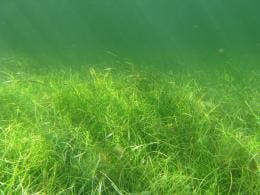A new research from a team of international marine geoscientists has found that seagrass meadows, found in coastal regions, can store up to twice as much carbon as temperate or tropical forests. The scientists involved in the study, thus, believe that seagrasses can potentially become a viable solution to climate change, if scaled and preserved through out the world.

Dense seagrass meadows in Florida's Coastal Everglades LTER site.(c) Florida Coastal Everglades LTER Site
Data suggests that coastal seagrass beds store up to 83,000 metric tons of carbon per square kilometer, mostly in the soils beneath them. Some seagrass beds have been found to store carbon for thousands of years in the roots and soil beneath them. Actually, seagrass beds store 90% of their carbon in the soil–and continue to build on it for centuries.
The research also estimates that, although seagrass meadows occupy less than 0.2 percent of the world’s oceans, they are responsible for more than 10 percent of all carbon buried annually in the sea.
“Seagrasses only take up a small percentage of global coastal area, but this assessment shows that they’re a dynamic ecosystem for carbon transformation,” said James Fourqurean, the lead author of the paper and a scientist at Florida International University and the National Science Foundation’s (NSF) Florida Coastal Everglades Long-Term Ecological Research (LTER) site.
Despite this, however, seagrass meadows are among the world’s most threatened ecosystems. Currently, some 29% of the world’s historic sea grass meadows have been destroyed, preponderantly caused by water pollution and dredging. It’s estimated some 1.5% of the world’s seagrass meadows are lost every year.
The current study explicitly shows how important, really, are seagrass ecosystems to the Earth’s climate and why preservation and rehabilitation efforts are required. Destruction of seagrass meadows can potentially emit up to 25 percent as much carbon as those from terrestrial deforestation, the researchers claim in the study recently published in the journal Nature Geoscience.
“One remarkable thing about seagrass meadows is that, if restored, they can effectively and rapidly sequester carbon and reestablish lost carbon sinks,” said paper co-author Karen McGlathery, a scientist at the University of Virginia and NSF’s Virginia Coast Reserve LTER site.
Besides storing carbon, seagrass beds are beneficial to the ecosystem also by filtering sediment from the oceans; protecting coastlines against floods and storms; and serving as habitats for fish and other marine life.
The research was led by Fourqurean in partnership with scientists at the Spanish High Council for Scientific Investigation, the Oceans Institute at the University of Western Australia, Bangor University in the United Kingdom, the University of Southern Denmark, the Hellenic Center for Marine Research in Greece, Aarhus University in Denmark and the University of Virginia.
source: physorg









